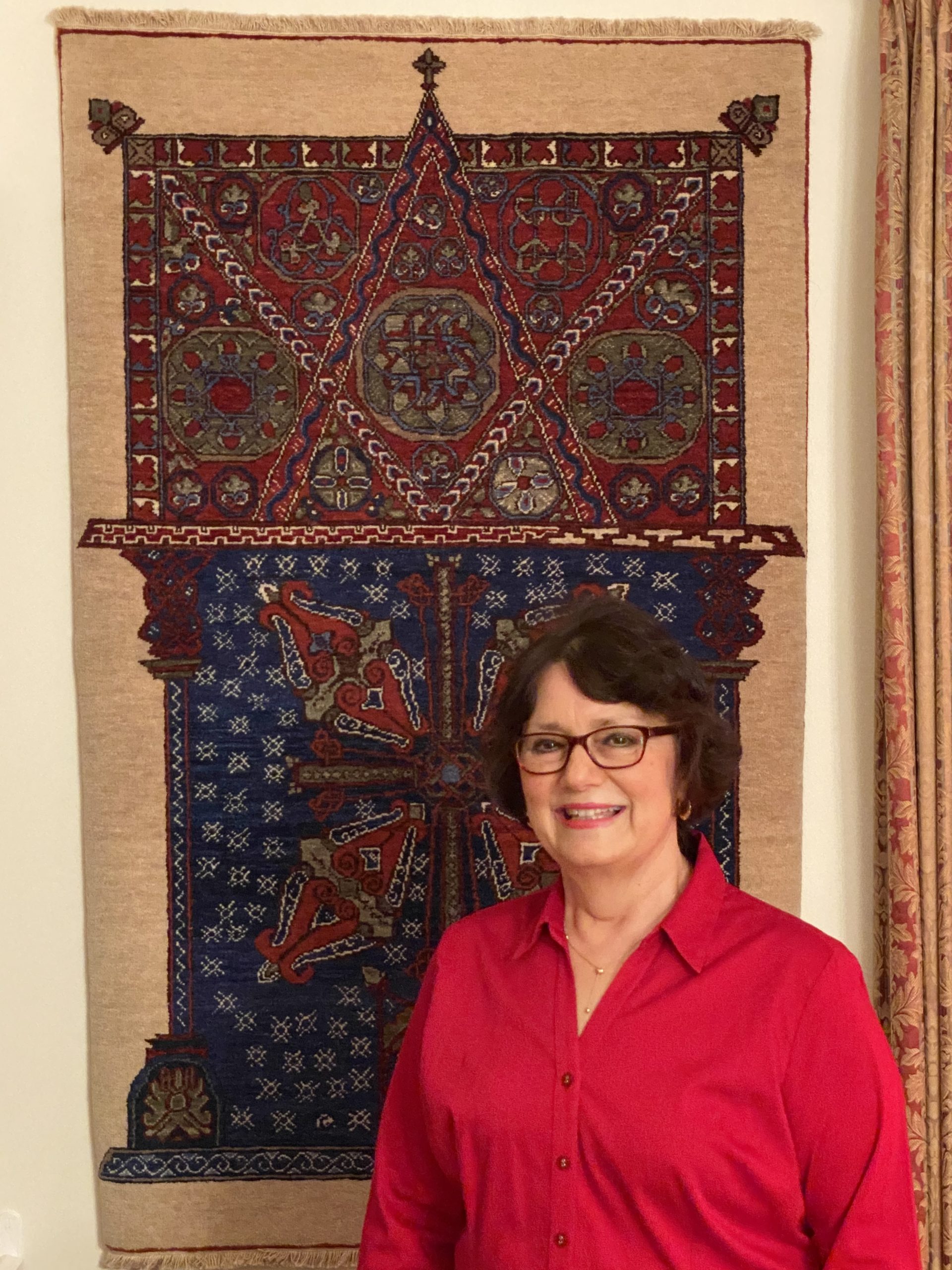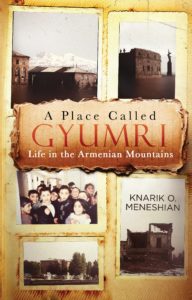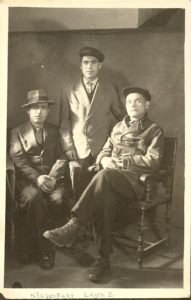The Armenian Weekly staff conducted the following interview with Knarik Meneshian, a longtime contributor to the Weekly and the author of the recently published book A Place Called Gyumri.

Knarik O. Meneshian was born in Austria. Her father was Armenian, and her mother was Austrian. She received her degree in literature and secondary education in Chicago, Illinois. In 1988, she served on the Selection Committee of the McDougal Littell “Young Writers Collection—Grades 1–8, an anthology of exemplary writing by students across the country.” In 1991, Knarik taught English in the earthquake-devastated village of Jrashen (Spitak region), Armenia. From 2002 to 2003, she and her late husband Murad A. Meneshian lived and worked as volunteers in Armenia for a year teaching English and computer courses in Gyumri and Tsaghgadzor. Meneshian’s works have been published in Teachers As Writers, American Poetry Anthology and other American publications, as well as Armenian publications in the U.S. and Armenia. She has authored a book of poems titled Reflections, and translated from Armenian to English Reverend D. Antreassian’s book titled The Banishment of Zeitoun and Suedia’s Revolt. She began writing at the age of 12 and has contributed pieces to the Armenian Weekly since her early teens.
Armenian Weekly: Talk about the most salient experiences that prompted you to consider writing a book about your experiences in Gyumri.
Knarik Meneshian: My experiences in Gyumri began in 1990, when it was called Leninakan. I was there with the ARS (Armenian Relief Society, Eastern Region), and it was my first time in that city. It was a gray, cold, day and everywhere I looked I saw ruin. Despite the calamity that had befallen the people, they were kind, warm and welcoming. Not far from the center of town, I saw children and their teachers holding red carnations as they stood shivering in front of a large, carved, memorial stone across from where their school had been. They were softly, reverently singing the Lord’s Prayer to their lost classmates, to lost students. The following year, in 1991, I was selected to teach English in Jrashen, a village next to Spitak, for a few months. Despite the devastating destruction that was everywhere: the cemeteries in the village and in Spitak crowded with headstones; the harsh and primitive living conditions of the people; and the lack of food, water, electricity, medicine, warm clothes, and shoes, the spirit of the children and their enthusiasm and love of learning was not dampened. It was among the ruins and cold mountain air and listening to the giggles and singing of the children that inspired me to return one day to Armenia.

Upon my return home in the winter of 1991, from time to time I would think of the children and people I had met both in Gyumri and Jrashen and hoped that someday I would be able to return to help in some way. As if a prayer had been answered, that day did come. Murad, my late husband, and I arrived in Gyumri in 2002 as Armenian Volunteer Corps teachers. Our work was to last approximately six months, but Murad and I had promised each other that if we ever did go to Armenia to be of help, we would stay for a full year. I am thankful for every moment we spent in Gyumri and for all of our year-long experiences there—some difficult, but mostly memorable. It was the walking around in the city, the taking in its sights and sounds, the talking to people and joining them in their homes for tea or coffee, the teaching—grade school children to college students and some adults—that inspired me to write about Gyumri and her people. My book is their story—a story of survival and resilience.
 A.W.: Discuss the process of writing A Place Called Gyumri.
A.W.: Discuss the process of writing A Place Called Gyumri.
K.M.: Though I jotted down notes when we first arrived in Gyumri, the process of writing my book began in our rented apartment in front of our bedroom window where I could see the activities below, such as people walking about, cars passing by, funeral and wedding processions, and from my kitchen window and balcony, watching women hang clothes on lines as they called out to each other, the courtyard activities I describe in the book, and the ever-present roaming street dogs. So to begin writing my story, one afternoon after my classes I walked into a little shop around the corner from where we lived and bought four notebooks and four pens. I wrote down thoughts, ideas and impressions of the city, and from time to time began taking photos and videos as well. Sometimes, though, I’d write poems of things I had seen, which I included in the book. Mostly, though, I looked and listened to what the city and her people had to reveal during the four seasons we were there. Each season, just as each person, had a different story to tell. When we returned home from our year in Armenia, I began researching in more detail the history of Gyumri and began writing a more detailed account of our work there as volunteer teachers. Eventually, I submitted segments of my Gyumri story to the Armenian Weekly. When the story came to an end, Khatchig Mouradian, the editor of the paper at the time, said, “Your Gyumri segments are material for a book. Do consider it.”
A.W.: In the preface of A Place Called Gyumri, you mention your fascination with Armenia, your first visit in 1975, and subsequent visits in the 1990s and 2000s. Talk about how your conception of the Republic of Armenia evolved over the years.

K.M.: My fascination with Armenia began well before my 1975 visit there to meet my father’s relatives. It began when my parents and I immigrated to the United States of America from Europe, where we had been DPs (displaced persons). In the DP camps, food was rationed and living conditions were extremely difficult. We were moved from the camp in Austria to France, and then to the camp in Germany, before being brought on an American battleship to America.

My father, who had been a POW and slave laborer in Europe, and before that a political prisoner in Siberia during Stalin’s reign of terror, had been a political activist in Armenia. He and his fellow young Armenians believed in freedom, and so they traveled from Yerevan to Gyumri to pass out anti-government literature. It was there, in Gyumri, that his life as a teacher, writer, and political activist came to an end. He had become a political prisoner. All his life, he loved reading and writing, both in Armenian and Russian. He wrote articles for The Hairenik for a number of years, and he was the author of a couple of books. His name was Suren Oganessian (Hovhanessian).

In America, with the assistance of the Armenian Relief Society (ARS), we settled in Chicago. Only a handful of Hayastansies (those from Armenia) lived in Chicago at the time. Most knew each other from the DP camps. Every so often, the men would come to our home on a Saturday evening to play chess, talk, eat a little food and drink a little whiskey. They all smoked cigarettes, and they always had a smile and a pat on the head for my siblings and me. It was in our home, with the gathering of the Hayastansies every so often, the playing of Armenian folk music, my father singing and dancing traditional Armenian dances on joyous occasions, and his love of reading and writing, that sparked a fascination for Armenia in me. As I spent more and more time with the people in Armenia in the 1990s, and later in the 2000s, both in Yerevan and in the regions, my feelings for Armenia grew even stronger. Perhaps because of my early childhood, I could relate to the people, and, to a good degree, understand them.
The first time I heard the Armenian national anthem sung (with the change of two words) at the Philharmonic Orchestra Hall in Yerevan, Loris Tjeknavorian conducting, I was filled with awe and great emotion. We, the audience, stood with our coats on singing — “Mer Hayrenik, azad, angakh… (Our Fatherland, free and independent…” Those two priceless words—Free and Independent—thundered throughout the chilly, somewhat dim, hall! As we took our seats to listen to the concert, I thought, this must have been how the Armenian people felt on May 28, 1918.

Then, while teaching in the village of Jrashen, I was given permission by the village “elders” to vote in our first election as a free and independent country. The reason, they said, was because my father had been from Armenia. I saw and experienced the voting process at that time.
To have seen Armenia during the Soviet times, then the cold, dark, hungry days when life had been turned upside down and inside out for the people of Armenia, beginning with the devastating 1988 earthquake, and observing the slow and steady progress in the country over the years, as well as witnessing, over and over again, the endurance and resilience of those who lived through the adversities of those unbearable, bleak days—the days of long bread lines, the lines of people patiently waiting to fill their buckets with water, people desperately selling what little they had for food and other necessities, the determination of children to continue with their schoolwork, even when there was only candlelight and no heat at all, speaks volumes of a people and nation.

A.W.: Prior to A Place Called Gyumri, you had also published a book of poetry, translated a book from Armenian and penned many non-fiction articles and essays for the Armenian Weekly. Talk about your writing process and how it has evolved over the years.
K.M.: Initially, I began writing poems at the age of 11, which were published over the years in the Armenian Weekly. At the age of 18, I was contacted by the Hairenik telling me that they were going to publish a book of my selected poems. It was titled Reflections. Eventually, my poetry writing also included community news writing, then fiction and non-fiction writing, which offered more freedom. I soon discovered that I greatly enjoyed the research aspect of writing.
A.W.: What are you working on next?
K.M.: Next, I will be working on a short story that I have been thinking about for a long time. The story will take place in the southern region of Armenia. In addition, I am gathering information for an article. Before I begin a work, I think about the topic for a long time and then I form an outline in my head. After that, I write my thoughts in a notebook, sometimes on sheets of paper. When I feel I have enough for a poem, story or article, I move to the computer.
A.W.: What are some of your favorite books, Armenian-themed and in general, on your bookshelf?
K.M.: There are so many, many books on my bookshelves—books on Armenian art, architecture, history, literature, music, and religion, also the Armenian encyclopedia. Among the many books are Raffi’s volumes, William Saroyan’s works, and works by various Armenian, American, and other authors. Periodicals also fill a bookshelf. Some of the books have been read more than once and some are waiting to be read. A few of my favorite books are: The Bard of Loree by Hovhannes Toumanian, translated by Mischa Kudian; Soviet Armenian Poetry, compiled and translated by Mischa Kudian; Anthology of Armenian Poetry, by Diana Der Hovanessian; Gentlemen Beggars, by Hagop Baronian; Bebo, by Gabriel Soondookian; We of the Mountains – Armenian Short Stories, translated by Fainna Glagoleva; Armenia – Travels and Studies by H.F.B. Lynch; Richard Hovhannisian’s books; The Armenians by Sirarpie Der Nersessian; The Forty Days of Musa Dagh by Franz Werfel; Writing Down the Bones by Natalie Goldberg.


Thank you for this revealing interview with Mrs. Meneshian. She has a beautiful way of describing live scenes and her latest book “‘A Place Called Gyumri’” is captivating from page 1. I found it less expensive to purchase on Hayrenik (https://hairenik.com/shop/a-place-called-gyumri-life-in-the-armenian-mountains-paperback-by-knarik-o-meneshian/) than on Amazon.
The book took me along through the daily life of the people of Gyumri. I’m sure it was encouraging to the locals and professions to have concern and love come to them from far away. With the story of Gyumri I got to visit a piece of time in the daily expressions of the people of Gyumri Armenia. Thanks to the Hairenik and Knarik for documenting their lives.
Karin – wonderful to read your articles!!
My father, Dee Sahag would have been pleased.
So nice to hear from you, Nora. I remember your dear parents, and the whole family, with great fondness.